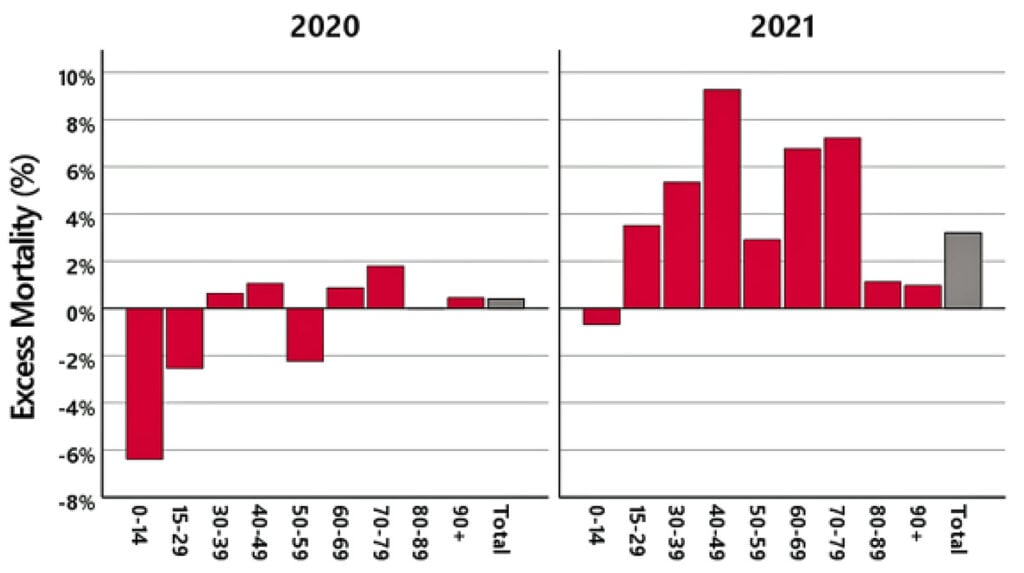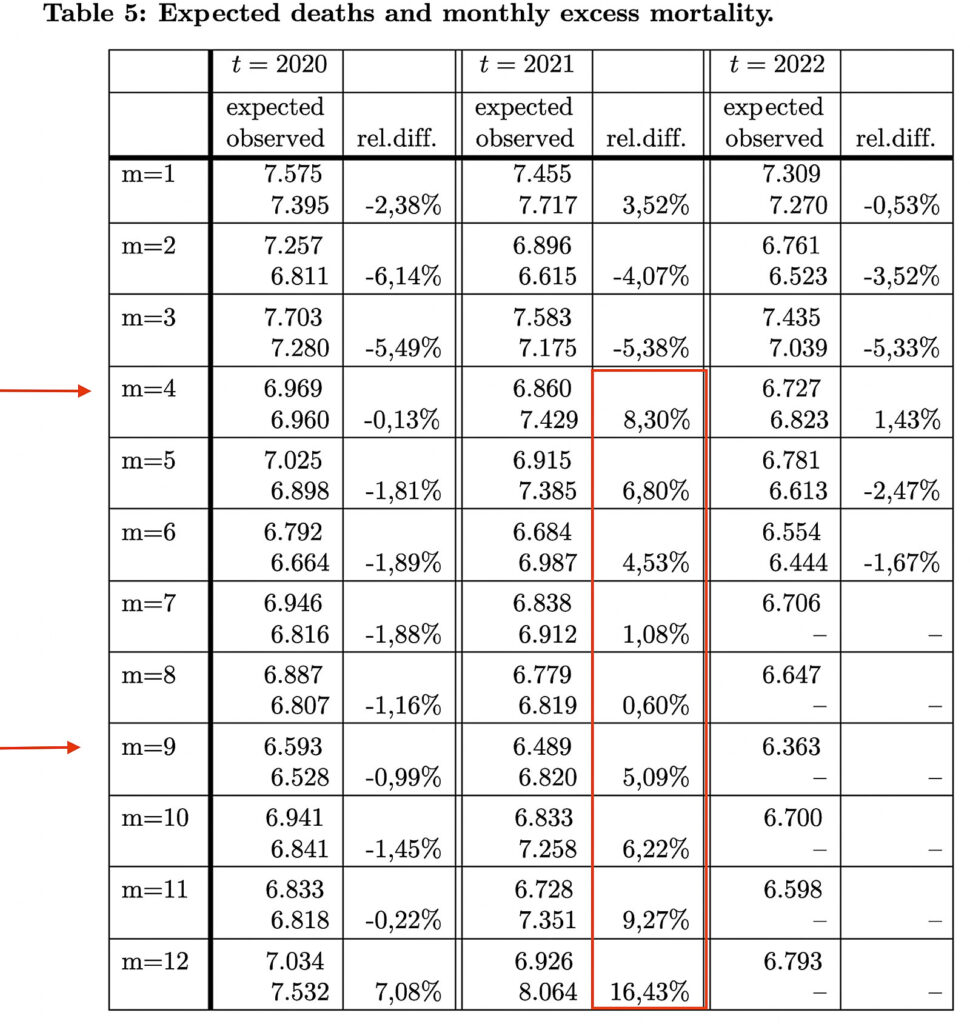COVID Vaccines Linked to Excess Deaths in Germany
Post# of 128826
An analysis by two German university professors of government data implicates COVID-19 vaccination as a factor in excess deaths in Germany, however, public health officials in Germany, the U.S. and elsewhere continue to ignore safety signals.
An analysis by two German university professors of government data implicates COVID-19 vaccination as a factor in excess deaths in Germany, however, public health officials in Germany, the U.S. and elsewhere continue to ignore safety signals.
Truth was the first casualty in the war on COVID-19.
Trusted sources of medical information became propaganda outlets and when that wasn’t enough, governments that controlled the raw data on which medical analysis was based withheld and even falsified that data.
All along, we have been piecing together indirect evidence. It paints a picture of a devastating toll from vaccine injuries in the past year.
No drug product in the past has come close to causing injuries on this scale. Injuries from the worst vaccines occurred at a rate of about 1/90th of the mRNA vaccines.
Thalidomide maimed tens of thousands of European babies, but the U.S. Food and Drug Administration was still protecting us in 1961. Compare this to 1.4 million vaccine injuries and 30,000 deaths in the last year-and-a-half, counting only those that were reported to the Vaccine Adverse Event Reporting System, or VAERS.
The only comparable drug disaster was oxycontin, which led to about 20,000 overdose deaths in its worst year.
The evidence is radioactive. No one in government wants to count up the deaths and injuries because of the political ramifications. Most medical researchers, even at universities, depend on money from the National Institutes of Health and the drug industry.
Hence, it’s refreshing to see an honest analysis of apparently honest government data. The analysis comes from Christof Kuhbandner and Matthias Reitzner, professors of sociology and mathematics, respectively, at two German universities.
The data is from the German Federal Statistical Office (Bundesamt für Statistik). I’m grateful to a fellow Substacker who writes under the pseudonym Eugyppius for calling my attention to this article and placing it in context.
Of course, what we would like to have is a count of deaths and hospitalizations due to COVID-19 and corresponding counts for deaths and hospitalizations due to the vaccines. This data has been disguised or deleted by governments around the world. The very definition of causality has been gamed for these two cases.
Draw your own conclusions.
But data on all-cause mortality are more difficult to disguise or reinterpret, as our two authors are quick to point out. This is a simple list of people who died, together with their age and sex, and with no overlaid story about how they met their demise.
The point is that we can find patterns in this data that hold implications for COVID-19 epidemiology and policy.
Here’s the bottom line: In 2020, we see a slight excess of death in the oldest age group, too small to be significant. In 2021, we see a large excess of death in young and middle-aged people.

Figure 5 (above) from the paper shows that even though COVID-19 was ravaging the globe in 2020, and COVID-19 deaths were heavily concentrated in the elderly, we can barely detect a (statistically insignificant) rise in mortality in 2020, for the oldest of the old.
This suggests that in 2020, COVID-19 deaths were largely confined to people who were old and sick, and would probably have died of something else if the virus had not hit them first.
But look at mortality in 2021. We see excess mortality in all the younger age groups. Yet once again, for the second year of COVID-19, there was nothing significant in people over 80.
If we think of 2021 as “the year of the vaccine,” our first impression is that the vaccine was a wash for people over 80 — the vaccine cost about as many lives as it saved.
But for people younger than 80, the costs outweighed the benefits.
Governments and their mouthpieces in the media would like to attribute the 2021 excess deaths to COVID-19 and lockdown measures. But this theory has two major issues.
First, why would there be more deaths from lockdown measures in 2021, if the measures were more restrictive in 2020?
Second, why would COVID-19 be more lethal in 2021, if Germans were protected by a vaccine?
Is it possible the lockdowns took nine months before their effect was felt? If so, why were the young disproportionately affected?
The authors of the academic paper stick to “just the facts, ma’am.” Except for one understated paragraph, they never use the word “vaccine.”
But they demonstrate that whatever it was that started killing young, healthy people, it began in April 2021.

Table 5 (above) from the paper shows the difference between expected and observed mortality in Germans ages 15 to 59, from January 2020 through June 2022.
There are two jumps in excess mortality in 2021 — one began in April and the other in September.
Vaccination began in December 2020, with frontline medical workers and the elderly.
For younger, working people, vaccination began in earnest in April 2021. The first round of boosters arrived in the fall.
The authors also break down what happened in the older age groups:

The graph above (fig. 9 from the paper) displays the cumulative number of excess deaths. We can see that the 80+ set received their first dose earlier than younger people (January 2021), and their death rates rose before the younger age group.
The superimposed blue arrows indicate where excess deaths begin to accrue more quickly in those 60- to 79-year-olds. Once again this occurs in the spring and autumn of 2021.
“Correlation is not proof of causation,” so draw your own conclusions.
What the actuarial tables reveal
I recommend the journal article as exceptionally readable and even-handed. The authors review other analyses of patterns in all-cause mortality. They point out that we are interested in departures from past trends, but there is no way to define those trends objectively.
To account for past trends quantitatively requires a computer model, and as we know, there are many ways to construct a computer model.
There are four moving parts to be accounted for:
Overall population is increasing.
Overall death rates are decreasing.
The proportions of the population in each age group are changing.
The mortality rates of these different subpopulations were already changing before COVID-19.
The authors acknowledge the strengths of previous analyses and note the places where one or more of these four adjustments were not part of the calculation.
They then proceed to their own analysis, based on actuarial tables.
You may already be familiar with how actuarial tables work. They are used to calculate insurance risk. Typically, they list probabilities of death for a one-year period, based on age, sex and sometimes race.
Insurance companies are motivated to make a profit, and they don’t mess around with fudge factors. That’s why it was so alarming when a number of insurance companies announced earlier this year that their group life policies had paid out higher benefits in the last half of 2021 — at an unprecedented level.
The authors track the trends in actuarial tables from the past several years and used them to construct tables for Germany in 2020 and 2021.
They combined these with census data for the number of Germans in each age group to create their estimates of how the actual number of deaths differed from expectations. That is the methodology that went into figure 5.
The database they used also includes dates for each death. The authors were able to track when the excess deaths among 30- to 79-year-olds occurred.
The answer: The excess deaths began in April 2021, and continued through most of the year. Deaths among people ages 60-79 were up 20% from April 2021 through March 2022.

The above graph shows us that in every age group, mortality was higher in the year of the vaccine. Isn’t that all we really need to know?
Here’s the corresponding graph for the U.S., computed with Centers for Disease Control and Prevention data:

The U.S. data (above) are qualitatively similar to Germany’s but there are some differences that have no obvious explanation.
The percentage increases for young people are about twice as high in the U.S. But for people over 75, there is actually a net decrease in mortality in the U.S. (but not in Germany).
Where’s the investigation?
Researchers at Children’s Health Defense and independent researchers around the world will continue to analyze evidence of the scope of injuries and deaths from the mRNA vaccines.
Direct evidence is not being collected, or it is being withheld by governments around the world. But the extent of the damage has been so devastating it cannot stay hidden.
This data presents a compelling story that incriminates the COVID-19 vaccine campaign as a significant factor in the rise in all-cause mortality — however, public health agencies continue to ignore this safety signal effortlessly.
How? Because correlation is not causation. Causation can only be established by investigation. Without any investigation, any causation can be hidden indefinitely. There is every motivation not to do the most important research.
https://childrenshealthdefense.org/defender/c...f0543533bb
 (0)
(0) (0)
(0)